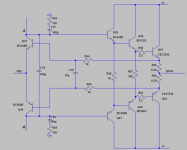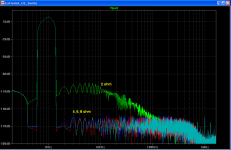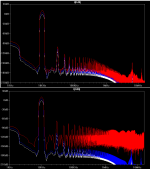Member
Joined 2009
Paid Member
I suppose you mean that when Iout =< 2 x Iq, then there is almost no distortion - I agree. But when Iout > 2Iq, distortion rises rapidly.
So what you are confirming is that this OPS is Class A only, it is not suitable when used outside the idle current limitations. If it were there would be many takers - the elusive search for low distortion Class AB without loop feedback.
We may say it this way. When in class A, it is perfect even outside FB loop (I have plenty of measurements). When in B-AB, FB has to fight with distortion, the transition is abrupt.
We may say it this way. When in class A, it is perfect even outside FB loop (I have plenty of measurements). When in B-AB, FB has to fight with distortion, the transition is abrupt.
PMA have you seen this similar idea of class AB buffer?
I`ve been simulating the circuit long time ago and the simulation results were very very good, it`s not class A and has no limitations of extrema (Allison type) buffer. If it could be made to work in real life it could be the perfect candidate for a buffer with no need for global FB around it...
http://www.diyaudio.com/forums/soli...ower-follower-output-stage-8.html#post3234657
When in B-AB, [snip], the transition is abrupt.
Pavel why is that, do you know?
I have seen many amplifiers going from A to (A)B but generally the transition was gradual, with distortion rising of course but not really abrubt.
Is that particular to this topology?
Jan
Pavel why is that, do you know?
I have seen many amplifiers going from A to (A)B but generally the transition was gradual, with distortion rising of course but not really abrubt.
Is that particular to this topology?
Jan
Forced arithmetic mean biasing, each side has half the current when either side gets all the current it hits the wall at twice the standing bias. The local loop that forces the arithmetic mean relationship loses control.
Feedback makes the transition from non clipped to clipped very abrupt.
The feedback "hangs on" trying to correct the output error and then finally gives up.
Could the feedback controlled ClassA bias also have an abrupt loss of control?
The feedback "hangs on" trying to correct the output error and then finally gives up.
Could the feedback controlled ClassA bias also have an abrupt loss of control?
PMA have you seen this similar idea of class AB buffer?
I`ve been simulating the circuit long time ago and the simulation results were very very good, it`s not class A and has no limitations of extrema (Allison type) buffer. If it could be made to work in real life it could be the perfect candidate for a buffer with no need for global FB around it...
http://www.diyaudio.com/forums/soli...ower-follower-output-stage-8.html#post3234657
Sort of a big CFA buffer, should work but might have source impedance issues that need care. These more complicated closed-loop buffers are sometimes a nightmare if you did want to apply GNF as well.
Yes, very strong feedback by input trannies, when 2Vre is above 2Vd it collapses. Sorry I write from phone.
Pavel why is that, do you know?
I have seen many amplifiers going from A to (A)B but generally the transition was gradual, with distortion rising of course but not really abrubt.
Is that particular to this topology?
Jan
Yes it is.
The input transistors of the OPS that are driven at their emitters also set the bias current which is determined by the emitter resistors at the output. The voltage between the two emitter resistors at the output is 2*Vbe, which is ~1.3V, this sets the bias point (V=I*R).
At some point, when the voltage between the two emitter resistors at the output is >2*Vbe, another mechanism kicks in that drives the output stage in a more conventional fashion, distortion is no determined by the local feedback loop around the emitter resistor and each individual output transistor.
Because this transition is rather abrupt, when >2*Vbe, the transistion to class-B is as well, not helped by the large value of the emitter resistors, the THD hits a proverbial brick wall and raises by as much as 30dB.
Last edited:
Adding to that, it is possible to remove the rather abrupt transition to class-B by removing the current sources, the OPS now has a built in overcurrent protection, when the output current exceeds a value that is twice the bias current the other output transistor shuts off as the current at the output is zero.
This does however mean that the OPS will have rather nasty clipping behavior, which shows up when Iout = 2xIbias. With the configuration that's in there now there's a transition to class-B rather than hard clipping. Which we thought was the preferred approach. Obviously the two current limiting transistors and the two diodes now handle overcurrent protection which kicks in at around 4xIbias, which for the 100W/8R setting is ~10A.
This does however mean that the OPS will have rather nasty clipping behavior, which shows up when Iout = 2xIbias. With the configuration that's in there now there's a transition to class-B rather than hard clipping. Which we thought was the preferred approach. Obviously the two current limiting transistors and the two diodes now handle overcurrent protection which kicks in at around 4xIbias, which for the 100W/8R setting is ~10A.
How about charge stored in C18, C19? (averaging, rectification)
How about distortion in class A, same or worse? I would guess it is worse with capacitors. I will check it as well.
Edit: OK, there is some improvement in class B.
How about distortion in class A, same or worse? I would guess it is worse with capacitors. I will check it as well.
Edit: OK, there is some improvement in class B.
Attachments
Last edited:
@BV,
Are the capacitor values chosen arbitrarily? Or is there some reason for picking these values?
Are the capacitor values chosen arbitrarily? Or is there some reason for picking these values?
20V amplitude of 20kHz sine makes 2.513V/us at zero crossing. You need 5 - 10x more to get reasonably low 19+20kHz CCIF.
Bridge needs 2x higher slew rate.
If you would like to learn the formula,..............D/A converters etc.
It is good that you know how to count.
I'm sure you know how much is the maximum output voltage SACD D/A converters for 200Hz and 20kHz
They are smoothing transition from class A to B, can be seen in the current shape through each of the two output devices.
Scott, you have erased your post?
Scott, you have erased your post?
- Status
- Not open for further replies.
- Home
- Amplifiers
- Solid State
- ExtremA, class-A strikes back?




